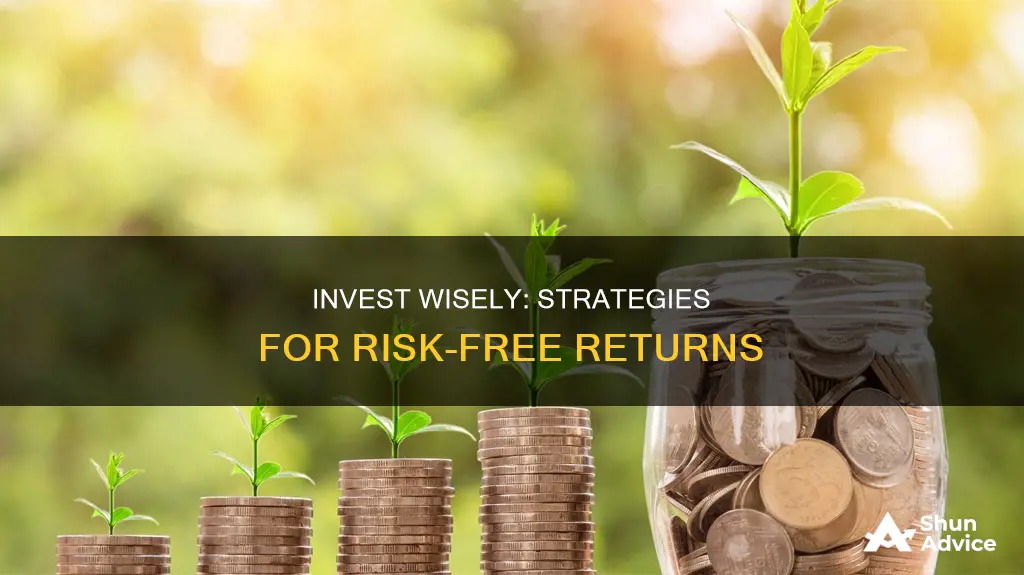
Investing without risk is impossible, but there are ways to mitigate risk. All investments carry some degree of risk, and it's important to understand the risks and rewards involved before investing. The main risk of investing is the possibility of losing money and not achieving expected returns. This could be due to the unpredictable nature of the market or economic issues. However, investing can give your money the potential to increase in value above and beyond inflation.
There are a variety of investment options available, each with its own level of risk and potential return. Generally, the lower the risk, the lower the potential return, and vice versa. Low-risk investments include high-yield savings accounts, money market funds, certificates of deposit (CDs), treasuries, and dividend-paying stocks. These options offer stable but modest returns and are suitable for short-term financial goals or for investors who want to protect their capital.
On the other hand, higher-risk investments, such as stocks, carry a greater potential for growth but also come with a higher chance of loss. It's essential to evaluate your comfort zone in taking on risk and to consider your financial goals and time horizon when deciding how much risk to take. Diversification is also a key strategy in managing investment risk, as it helps to spread your risk across multiple investments.
While it's not possible to invest without risk, understanding the risks involved and making informed decisions can help you find the right balance between risk and return to suit your financial goals and risk tolerance.
| Characteristics | Values |
|---|---|
| Risk-free investments | US treasuries and CDs |
| Risk-averse investors | Older individuals |
| Low-risk investments | High-yield savings accounts, money market funds, short-term certificates of deposit, cash management accounts, dividend-paying stocks, annuities, cash-value life insurance |
| High-risk investments | Stocks, options, futures |
| Risk-return trade-off | Higher-risk investments have higher returns |
| Risk management | Diversification, mutual funds, multi-asset mutual funds |
| Risk tolerance | Depends on financial goals, time horizon, age |
What You'll Learn

High-yield savings accounts
- High-yield savings accounts are ideal for emergency funds or short-term savings goals. They offer easy access to your money while allowing you to earn a higher rate of interest.
- These accounts are federally insured, typically by the FDIC (Federal Deposit Insurance Corporation) or NCUA (National Credit Union Administration). This insurance protects your deposits up to a certain limit, usually $250,000 per depositor.
- The best high-yield savings accounts offer competitive interest rates, no or low minimum balance requirements, and no monthly maintenance fees.
- Some popular options for high-yield savings accounts include LendingClub LevelUp Savings, Newtek Bank Personal High Yield Savings, Synchrony Bank High Yield Savings, and Ally Bank Savings Account.
- While high-yield savings accounts provide a relatively safe investment option, it's important to consider the potential drawbacks. These accounts may have limited physical branch access, and transferring funds between different institutions can take a few days. Additionally, interest rates on these accounts can fluctuate over time.
Equity Investments: What Are They and How Do They Work?
You may want to see also

Money market funds
> "The bank tells you what rate you'll get, and its goal is that the value per share won't be less than $1."
Clo Equity: Who's Investing and Why?
You may want to see also

Short-term certificates of deposit
CDs are ideal for investors who don't need immediate access to their funds and are looking for higher returns than those offered by traditional savings accounts. By investing in a CD, you can lock in an attractive fixed rate and earn higher returns, with the added benefit of guaranteed growth. The best CD rates can offer APYs of up to 4.50%, which is significantly higher than the national average of 1.83% for a one-year CD.
When investing in a CD, it's important to remember that your funds will be tied up for the specified term. Early withdrawal is usually subject to penalties, and you may lose some of the interest you've earned, or even a portion of your principal. Additionally, if you lock into a longer-term CD and overall interest rates rise, you may find yourself earning less than you could have if you'd invested elsewhere.
To find the best CD rates, it's recommended to shop around and compare what different banks are offering. Some banks also offer specialty CDs, such as no-penalty CDs, which allow you to withdraw your money without incurring a penalty, and bump-rate CDs, which let you increase your rate once during the term.
Savings and Investments: Planning for Your Future
You may want to see also

Cash management accounts
CMAs feature bank sweeps that move any uninvested cash in the account to program banks, where they earn interest. The partnership that CMAs have with banks allows them to offer competitive interest rates and keep more of your cash federally insured.
Wealthfront Cash Account
Wealthfront Cash Account offers a 4.00% APY, with no fees, and customers receive a debit card that allows them to withdraw cash from more than 19,000 fee-free ATMs. They can also use their account to pay bills and link to apps such as Venmo and Cash App to send money to friends and family. Direct deposit with payments of up to two days early is also available, and Wealthfront Cash customers can get up to $8 million in FDIC insurance coverage through partner banks.
Betterment Cash Reserve
The Betterment Cash Reserve cash management account has a promotional rate of 4.50% annual percentage yield for three months once new account holders fund their accounts. The Cash Reserve account and the companion Betterment Checking account have no fees and no minimum balance requirement beyond the $10 it takes to open the account, and individual accounts receive up to $2 million in FDIC insurance coverage through partner banks. Betterment Checking offers a debit card, mobile check deposit, and reimbursement of ATM fees worldwide.
Empower Personal Cash
Empower Personal Cash offers a 4.70% APY as well as robust budgeting features through its solid mobile apps. It also has no fees or minimum balance, which means it’s a pretty low-cost way to earn a high interest rate. However, Empower Personal Cash currently doesn’t support cash deposits, cash withdrawals, or check writing. Electronic transfers, wire transfers, and direct deposits are supported.
Vanguard Cash Plus Account
The Vanguard Cash Plus account offers a high-yield interest rate with no minimum balance requirements. The account has no fees as long as you sign up for e-statements; otherwise, the account has an annual fee of $25. Customers can get up to $1.25 million in FDIC insurance on individual accounts through partner banks.
Fidelity Cash Management Account
The Fidelity Cash Management Account has no monthly fees or minimum balance requirements and offers unlimited ATM fee reimbursement and free check writing. The account carries FDIC insurance of up to $5 million through Fidelity’s partner banks.
Equities: The Smart Investment Choice for Your Money
You may want to see also

Dividend-paying stocks
Additionally, reinvesting dividends can significantly enhance total returns over time through the power of compounding. This involves using dividends to purchase more shares, thereby increasing future dividend payouts. This can lead to exponential growth of the investment portfolio over time.
However, it is important to carefully select dividend-paying stocks as they may have limited growth potential. Companies that pay high dividends might reinvest less of their profits into expansion projects or research and development, resulting in slower stock price appreciation. Dividends can also be cut or suspended during economic downturns, impacting income-dependent investors.
In conclusion, dividend-paying stocks offer a regular income stream, the potential for lower volatility, and enhanced total returns through reinvestment. However, investors should be cautious of companies with unsustainable payout ratios or those at risk of cutting dividends. By focusing on financially healthy companies with a strong dividend history, investors can build a robust portfolio designed to generate reliable income while potentially appreciating in value.
Diversifying Taxable Investment Portfolios: Strategies for Long-Term Success
You may want to see also
Frequently asked questions
No investment is entirely risk-free. Even the safest options carry the risk of inflation outpacing yield, leading to a decrease in purchasing power over time.
Low-risk investments include high-yield savings accounts, money market funds, certificates of deposit (CDs), treasurys, and dividend-paying stocks.
Low-risk investments generally offer lower returns than riskier assets. They are useful for short-term financial goals or as a safety net to fall back on during market downturns.







